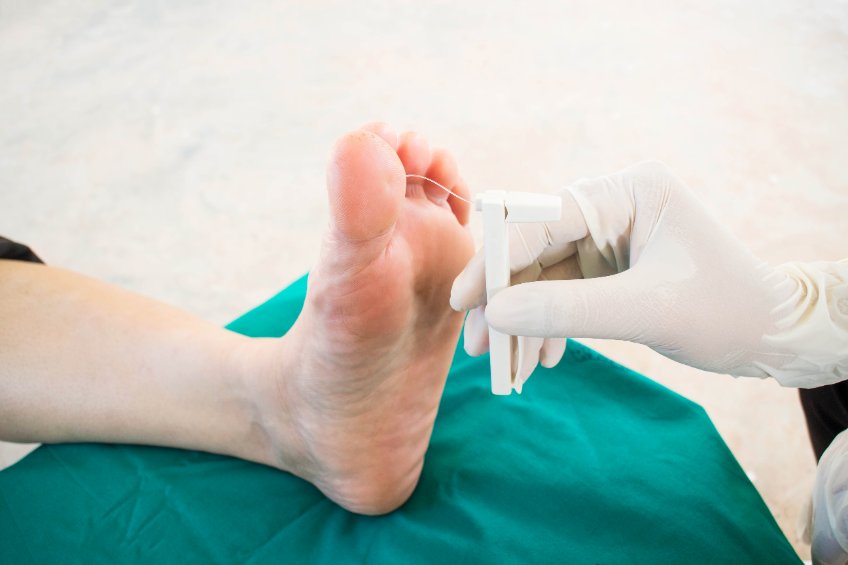Diabetic Foot Care is a Key Component of Healthy Diabetes Maintenance
A chronic condition in which the body is unable to maintain normal blood sugar levels, diabetes can gradually eat away at parts of the body if not well controlled. Diabetes is grouped into two types: juvenile diabetes where there is no insulin production due to destruction of the cells of the pancreas, and maturity onset diabetes, where there is resistance to the insulin hormone. Insulin is the main hormone produced by pancreatic cells and is required for breakdown and absorption of glucose circulating in the blood. Any damage to the pancreas leads to reduction or absence of Insulin production.
Because foot problems are extremely common in diabetes patients, patients must be well educated in diabetic foot care to ensure their legs and feet remain healthy.

DIABETIC FOOT CARE AND NERVE SENSATION
In diabetes, there are many of processes taking place simultaneously that finally lead to damaging the various tissues of the foot. Firstly, there is a reduced sensation in the extremities. This is because of diabetic neuropathy or damage to the smaller nerves of the foot by consistently elevated blood glucose levels. Since there are no sensations felt in the feet, one may not realize if there is an injury, as there will be no pain sensed. As soon as blood sugar levels are off balance, a person becomes more vulnerable to infections.
Diabetic persons catch infections more easily and the wounds do not heal quickly. Reduced sensations along with easy access to infections produce a favorable environment for the growth of infection, thus leading to production of ulcers. The most dangerous situation is foot problems associated with diabetes as one may not feel a blister, sore or even an injury by nail till its large enough to be visible. Thus, it is necessary to examine the foot each day, at the end of the day for diabetics.
DIABETIC FOOT CARE AND ULCERS
An ulcer formation is a potentially fatal condition for diabetics as it will lead to formation of gangrene if not treated in time. The ulcer formation is a slow and gradual process with oozing of pus. On examination of the foot one may initially see redness, edema and inflamed skin called as cellulitis leading to an ulcer formation. An ulcer is a break in the normal skin with wounds formed deeper than the top layer of the skin. If the infection of the foot travels still deeper into the bone, it may lead to osteomyelitis (infection and inflammation of the bones).
If the wound of the foot starts smelling bad or rotten, it may be due to the decaying tissues in and around the wound, and this marks the beginning of gangrenous changes in the foot. Gangrene foot is the result of a person suffering from uncontrolled diabetes and is a potential factor for permanently losing feet, as, if the wound does not heal by debridement, one may have to go in for amputation of the part.
It is very common that we see missing toes and certain portions of the feet in diabetic patients as there may have been removal of the gangrenous portions multiple times.

DIABETIC FOOT PAIN
If we quickly understand the pathology undergoing the disease, we may see that there is extreme pain in the feet of a diabetic person. Even a light touch or any pressure on the feet will cause tremendous amount of pain, generally out of proportion to the touch. One may also feel a burning sensation in the feet that is not relieved easily. This is due to inflammation of nerves due to long standing diabetes and if it persists unchecked, will lead to permanent sensation loss.
DIABETIC FOOT CARE AND INFECTION
The candida organism causes rampant fungal infection of the feet in persons suffering from diabetes. The infection usually attacks the skin between the toes where there is dampness along with absence of sensation. Commonly, there is adequate oxygenated blood circulating in the arteries of legs but in diabetics there is stiffness of the arteries causing decreased amounts of nutrients and oxygen to the feet. This process leads to lesser efficiency in clearing the infection.
Bacterial as well as fungal infection both grow in ample quantity without sufficient blood supply reaching to those parts. Toenails affected by fungal infection is a very common feature amongst diabetics. It takes a much longer duration to completely heal
One must be extremely vigilant and a lot of care should be taken to avoid injury to the foot.
FOR HELP UNDERSTANDING PROPER DIABETIC FOOT CARE, PLEASE CONTACT US AT 225-754-8888 OR CONTACT US HERE.
Dr. Meredith Warner is a board certified, Fellowship Trained Foot and Ankle, Orthopedic surgeon practicing in Baton Rouge, Louisiana. Dr. Warner is committed to offering her patients an accurate diagnosis along with a comprehensive treatment plan in order to get them back to a pain free life. Dr. Meredith Warner specializes in the treatment of orthopedic issues, providing operative and non-operative treatment plans of orthopedic problems, including musculoskeletal pain such as chronic back, neck and foot pain, reconstructive surgery of the foot and ankle, arthritis, diabetic, hammer toe, bunion, wound care, work injuries, fitness and nutrition and osteoporosis issues.






